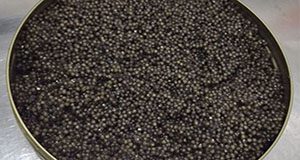Aquaculture is an important and diverse segment of the agricultural economy in Florida. Ornamental, live bait, food finfish, and other segments of this industry culture and trade in non-native species. Escape or release of these non-native cultured organisms is an environmental and legal concern in Florida and therefore a key consideration in aquaculture farm construction and operation. This 7-page fact sheet is the first in a four-part series devoted to educating industry and other stakeholders on the importance of preventing the escape of non-native species from aquaculture facilities as well as strategies for non-native species containment and regulatory compliance. Written by Quenton M. Tuckett, Carlos V. Martinez, Jared L. Ritch, Katelyn M. Lawson, and Jeffrey E. Hill and published by the School of Forest Resources and Conservation Program in Fisheries and Aquatic Sciences, it introduces the series, explains why non-native species containment is important, provides information on regulations, including the Florida Aquaculture Best Management Practices rule, describes the BMP inspection process, and provides advice on achieving compliance with these important regulations.
http://edis.ifas.ufl.edu/fa195
Category: Aquaculture
Technically Speaking, What Is Sturgeon Caviar?
People all over the world eat fish and shellfish eggs. Seafood roes are among the most valuable of fishery commodities because they are considered a delicacy and sell for a high price. The eggs can be acquired as whole roe, (the eggs still attached to the ovary, as with mullet), or as individual eggs that may be collected directly from where the female deposits or spawns her eggs (for instance, “tobiko,” from flying fish), or by harvesting the female and separating the eggs from the ovary (as with salmon, lumpfish, and sturgeon “caviar”). The most sought-after and high-valued of all seafood roes are the eggs obtained from the sturgeon. Traditionally coveted by royalty and the aristocracy, sturgeon caviar today is prized by chefs and discerning food connoisseurs the world over for its delicate flavor and nutrient-rich health benefits. Learn what caviar is, find out how it’s collected, and discover more about the fascinating sturgeon fish in this 4-page fact sheet written by Frank A. Chapman and Joel P. Van Eenennaam and published by the School of Forest Resources Program in Fisheries and Aquatic Sciences.
http://edis.ifas.ufl.edu/fa194
A Semen Extender for the Short-Term Storage of Fish Sperm
Aquaculturists worldwide use artificial or induced spawning of fish to maximize egg and larval production from fish that cannot normally be bred in captivity. Despite the wide global use of this technique, and much literature published, the success rates of induced spawning are consistently variable. One often overlooked reason for the variable success rates is that successful rates of fertilization, hatching, and larval survival are most dependent on high-quality sperm and the surrounding fluid that supports sperm function. It is difficult to obtain consistent, good-quality spermiations (releases of spermatozoa); to keep sperm alive after collection and during storage and transport; and to freeze large volumes of semen at one time. Therefore, a successful fish breeding program requiring sperm begins with a source of high-quality semen, and its proper collection, handling, and storage. This three-page article written by Frank A. Chapman and published by the Program in Fisheries and Aquatic Sciences in the School of Forest Resources and Conservation describes how to make and use a semen extender that will maximize the volume and preserve the viability of obtained semen.
http://edis.ifas.ufl.edu/fa193
Molluscan Shellfish Aquaculture and Production

Molluscan shellfish aquaculture provides high quality and high value seafood for human consumption, and shellfish provide environmentally beneficial ecosystem services, such as nutrient extraction and water filtration, to the environment in which they are grown. In the past five decades, global fisheries and aquaculture have grown steadily, and seafood consumption per capita has increased. Molluscan shellfish has traditionally been a major component of world aquaculture. Today, molluscs are cultured in 76 countries. This 8-page fact sheet written by Huiping Yang, Leslie N. Sturmer, and Shirley Baker describes molluscan shellfish aquaculture in the United States and worldwide and outlines molluscan shellfish aquaculture stages and methodologies.
http://edis.ifas.ufl.edu/fa191
Candidate Species for Florida Aquaculture: Gulf Killifish, Fundulus grandis
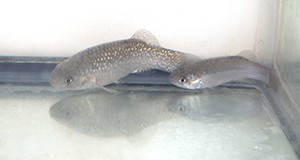
The Gulf killifish is a promising species for commercial aquaculture in Florida with the potential to help diversify the marine baitfish aquaculture industry in Florida and throughout the southeastern United States. Methods for culturing this species have improved in the past decade; this 6-page fact sheet describes the new methods and some strategies to give producers greater control of reproduction, larval growth, and survival. The publication provides the information producers need to make the most informed decision possible when considering Gulf killifish aquaculture. Written by Shane W. Ramee, Joshua T. Patterson, Cortney L. Ohs, and Matthew A. DiMaggio and published by the Program in Fisheries and Aquatic Sciences, School of Forest Resources and Conservation.
http://edis.ifas.ufl.edu/fa190
Spironucleus Infestations (Spironucleosis) in Freshwater Aquarium Fish
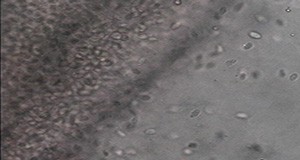
A group of species of single-celled parasites called Spironucleus cause disease in aquacultured and captive fish. Found in cold, temperate, and tropical climates, Spironucleus species can infect a variety of freshwater and marine ornamental and food fish, as well as crustaceans and shellfish.
Five species of Spironucleus are currently recognized: S. salmonicida, S. barkhaus, and S. torosa can infest marine organisms, while S. salmonis and S. vortens can infest freshwater ornamental fish. This four-page fact sheet written by Ruth Francis-Floyd and Roy P. E. Yanong and published by the Department of Large Animal Clinical Sciences focuses on S. vortens and its effects on ornamental cichlids, explaining which cichlids are susceptible, how to identify S. vortens , and how to confirm, manage, and prevent S. vortens infestations. (Photo credit: Roy P. E. Yanong, UF/IFAS Extension Tropical Aquaculture Laboratory)
http://edis.ifas.ufl.edu/vm053
Carp Edema Virus Disease (CEVD) / Koi Sleepy Disease (KSD)
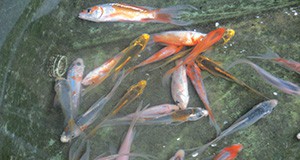
Carp edema virus disease is killing wild and cultured varieties of carp and worrying koi enthusiasts and carp aquaculturists in the United States and around the world. The disease causes skin lesions and swelling and is sometimes called “koi sleepy disease” because infected fish become lethargic and unresponsive. This 5-page fact sheet describes symptoms, diagnosis, prevention, and what fish producers, wholesalers, or retailers can do if they suspect carp may have contracted the disease. Written by Shohreh Hesami, Pedro Viadanna, Natalie Steckler. Staci Spears, Patrick Thompson, Karen Kelley, Roy Yanong, Ruth Francis-Floyd, Johnny Shelley, Joseph Groff, Andy Goodwin, Olga Haenen, and Thomas Waltzek, and published by the School of Forest Resources and Conservation Program in Fisheries and Aquatic Sciences.
http://edis.ifas.ufl.edu/fa189
Using Airlifts to Collect and Concentrate Copepod Nauplii
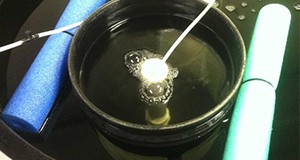
Airlifts are simple and inexpensive and not new to aquaculture. The buoyancy of rising bubbles within a pipe or tube generates an upward flow of water that are often used as part of water treatment design in recirculating aquaculture systems, but can also be used to collect and concentrate live food organisms fed to marine fish larvae. Airlifts are more gentle and efficient than sieving. This 3-page fact sheet provides protocols and designs for harvesting and feeding copepod nauplii to marine fish larvae, but these methods can be adapted for use with many live feed organisms. Written by Eric Cassiano, Matthew DiMaggio, Cortney Ohs, and John Marcellus, and published by the UF Department of Fisheries and Aquatic Sciences, May 2015. (Photo credit: Jason S. Broach)
http://edis.ifas.ufl.edu/fa188
Candidate Species for Marine Ornamental Aquaculture: Porkfish, Anisotremis virginicus
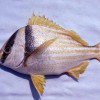 The porkfish is a member of the grunt family, which create a characteristic “grunting” sound by rubbing their pharyngeal teeth together during periods of agitation or courtship. Many species of grunts are popular in public aquariums because they’re abundantly available, and their schooling behavior and bright colors create interest in aquarium exhibits. Porkfish also have additional appeal to aquarists because they are “cleaner” fish during their juvenile phase, picking parasites from larger fish and other vertebrates. Scientists and aquarists have recently achieved a greater understanding of appropriate aquaculture protocols for grunts in general and porkfish in particular. These characteristics and advancements have led to porkfish being identified as a candidate species for commercial aquaculture. This 5-page fact sheet was written by Eric Cassiano and Kevin Barden, and published by the UF Department of Fisheries and Aquatic Sciences, October 2014. (Photo by George H. Burgess, Florida Museum of Natural History)
The porkfish is a member of the grunt family, which create a characteristic “grunting” sound by rubbing their pharyngeal teeth together during periods of agitation or courtship. Many species of grunts are popular in public aquariums because they’re abundantly available, and their schooling behavior and bright colors create interest in aquarium exhibits. Porkfish also have additional appeal to aquarists because they are “cleaner” fish during their juvenile phase, picking parasites from larger fish and other vertebrates. Scientists and aquarists have recently achieved a greater understanding of appropriate aquaculture protocols for grunts in general and porkfish in particular. These characteristics and advancements have led to porkfish being identified as a candidate species for commercial aquaculture. This 5-page fact sheet was written by Eric Cassiano and Kevin Barden, and published by the UF Department of Fisheries and Aquatic Sciences, October 2014. (Photo by George H. Burgess, Florida Museum of Natural History)
http://edis.ifas.ufl.edu/fa187
Tracking the Economic Benefits Generated by the Hard Clam Aquaculture Industry in Florida
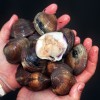 The hard clam industry is a true success story for commercial aquaculture in Florida. From a cottage industry borne of reductions in commercial wild clam harvests in the Indian River Lagoon during the late 1980s, hard clam aquaculture has now developed into an industry that is rivaled by no other aquaculture food product in Florida. Although successful by virtually any metric, the risks and uncertainty associated with commercial hard clam culture has led to the evaluation of programs that help mitigate risk, such as the former pilot Cultivated Clam Crop Insurance Program administered by USDA Risk Management Agency. All of this alludes to the economic importance of the hard clam culture industry which, through the cultivation process and sales of products, generates local income and taxes, creates jobs and businesses, and draws new money into the local economy, as cultured hard clams are sold to non-residents and buyers outside the region and state. This 6-page fact sheet provides an overview of a recent study by the University of Florida to provide an estimate of the impact of the hard clam industry to the Florida economy. Written by Charles Adams, Leslie Sturmer, and Alan Hodges, and published by the UF Department of Food and Resource Economics, October 2014. (UF/IFAS photo by Tom Wright)
The hard clam industry is a true success story for commercial aquaculture in Florida. From a cottage industry borne of reductions in commercial wild clam harvests in the Indian River Lagoon during the late 1980s, hard clam aquaculture has now developed into an industry that is rivaled by no other aquaculture food product in Florida. Although successful by virtually any metric, the risks and uncertainty associated with commercial hard clam culture has led to the evaluation of programs that help mitigate risk, such as the former pilot Cultivated Clam Crop Insurance Program administered by USDA Risk Management Agency. All of this alludes to the economic importance of the hard clam culture industry which, through the cultivation process and sales of products, generates local income and taxes, creates jobs and businesses, and draws new money into the local economy, as cultured hard clams are sold to non-residents and buyers outside the region and state. This 6-page fact sheet provides an overview of a recent study by the University of Florida to provide an estimate of the impact of the hard clam industry to the Florida economy. Written by Charles Adams, Leslie Sturmer, and Alan Hodges, and published by the UF Department of Food and Resource Economics, October 2014. (UF/IFAS photo by Tom Wright)
http://edis.ifas.ufl.edu/fe961
A Practical Guide for Aquaponics as an Alternative Enterprise
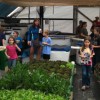 Aquaponics is an intensive sustainable agricultural production system that connects hydroponic and aquaculture systems to produce multiple cash crops with reduced water and fertilizer inputs. It is highly suited for small farm producers targeting local markets and agritourism opportunities. This 10-page fact sheet was written by Richard Tyson and Eric Simonne, and published by the UF Department of Horticultural Sciences, September 2014.
Aquaponics is an intensive sustainable agricultural production system that connects hydroponic and aquaculture systems to produce multiple cash crops with reduced water and fertilizer inputs. It is highly suited for small farm producers targeting local markets and agritourism opportunities. This 10-page fact sheet was written by Richard Tyson and Eric Simonne, and published by the UF Department of Horticultural Sciences, September 2014.
http://edis.ifas.ufl.edu/hs1252
Waterhyacinth: Florida's Worst Floating Weed
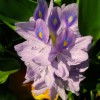 Waterhyacinth is one of the world’s worst aquatic weeds and is Florida’s most intensively managed floating plant. Dense mats formed by this species interfere with human uses of water bodies and disrupt ecosystems by preventing penetration of light and oxygen into the water column. This attractive, free-floating aquatic plant grows throughout the year in southern Florida but often dies back during the winter in the northern parts of the state. Waterhyacinth is cultivated as a water garden and pond plant, but cultivation, sale, and possession of this noxious weed is prohibited in Florida. This 5-page fact sheet was written by Lyn A. Gettys, and published by the UF Department of Agronomy, September 2014.
Waterhyacinth is one of the world’s worst aquatic weeds and is Florida’s most intensively managed floating plant. Dense mats formed by this species interfere with human uses of water bodies and disrupt ecosystems by preventing penetration of light and oxygen into the water column. This attractive, free-floating aquatic plant grows throughout the year in southern Florida but often dies back during the winter in the northern parts of the state. Waterhyacinth is cultivated as a water garden and pond plant, but cultivation, sale, and possession of this noxious weed is prohibited in Florida. This 5-page fact sheet was written by Lyn A. Gettys, and published by the UF Department of Agronomy, September 2014.
http://edis.ifas.ufl.edu/ag385
Grass Carp, the White Amur: Ctenopharyngodon idella Cuvier and Valenciennes (Actinopterygii: Cyprinidae: Squaliobarbinae)
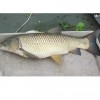 The grass carp, Ctenopharyngodon idella Cuvier and Valenciennes, was imported to the U.S. in 1963 as a biological control agent for hydrilla (Hydrilla verticilliata (L.f.) Royle) and other aquatic plants. Concerns of escape and reproduction, and the potential impacts that colonization of the fish could have on native flora and fauna led to research that developed a non-reproductive fish, which was equally effective in controlling hydrilla. In the warm waters of Florida, with abundant food, grass carp grow quickly at around 2 lbs/month or 0.91 kg/month and may achieve weights of 97 lbs (44 kg). Younger fish and female fish grow faster than older or male fish. Grass carp are the most effective biological control tool that has been identified for hydrilla. This 7-page fact sheet was written by Emma N.I. Weeks and Jeffrey E. Hill, and published by the UF Department of Entomology and Nematology, June 2014.
The grass carp, Ctenopharyngodon idella Cuvier and Valenciennes, was imported to the U.S. in 1963 as a biological control agent for hydrilla (Hydrilla verticilliata (L.f.) Royle) and other aquatic plants. Concerns of escape and reproduction, and the potential impacts that colonization of the fish could have on native flora and fauna led to research that developed a non-reproductive fish, which was equally effective in controlling hydrilla. In the warm waters of Florida, with abundant food, grass carp grow quickly at around 2 lbs/month or 0.91 kg/month and may achieve weights of 97 lbs (44 kg). Younger fish and female fish grow faster than older or male fish. Grass carp are the most effective biological control tool that has been identified for hydrilla. This 7-page fact sheet was written by Emma N.I. Weeks and Jeffrey E. Hill, and published by the UF Department of Entomology and Nematology, June 2014.
http://edis.ifas.ufl.edu/in1038
American Lotus, Yellow Lotus: Nelumbo lutea
 American lotus is an ideal native plant for constructed or restored wetland areas, where it provides shelter, habitat, and food for wildlife. It is an herbaceous aquatic perennial native plant that tolerates a wide range of conditions. The fragrant yellow flowers, huge round leaves, and persistent seed pods borne on stiff stalks high above the water make it both distinctive and visually striking. Native American tribes treated the American lotus as a sacred plant with mystical powers, and many tribes ate the large rhizomes and used parts of the plant for medicinal purposes. This 3-page fact sheet was written by Warner Orozco-Obando and Lyn Gettys, and published by the UF Department of Agronomy, March 2014.
American lotus is an ideal native plant for constructed or restored wetland areas, where it provides shelter, habitat, and food for wildlife. It is an herbaceous aquatic perennial native plant that tolerates a wide range of conditions. The fragrant yellow flowers, huge round leaves, and persistent seed pods borne on stiff stalks high above the water make it both distinctive and visually striking. Native American tribes treated the American lotus as a sacred plant with mystical powers, and many tribes ate the large rhizomes and used parts of the plant for medicinal purposes. This 3-page fact sheet was written by Warner Orozco-Obando and Lyn Gettys, and published by the UF Department of Agronomy, March 2014.
http://edis.ifas.ufl.edu/ag380
Rotala: A New Canal Invader in Southern Florida
 Rotala is a relative newcomer to Florida. Since it was first found in Coral Springs in 1996, it has established large, but mostly isolated, populations throughout the southern regions of Florida. It is especially problematic in Lee and Collier Counties and along the west coast. Extremely dense submersed populations and large thick mats dominate the surface of the water, greatly reducing ecosystem services, because oxygen level and light penetration are hampered. Because the rapid and vigorous growth of rotala inhibits water flow, the ability of infested canals to function properly in flood control systems is greatly hindered. Management of this aquatic weed is a major concern for resource managers. This 4-page fact sheet was written by Lyn A. Gettys and Carl J. Della Torre II, and published by the UF Department of Agronomy, April 2014.
Rotala is a relative newcomer to Florida. Since it was first found in Coral Springs in 1996, it has established large, but mostly isolated, populations throughout the southern regions of Florida. It is especially problematic in Lee and Collier Counties and along the west coast. Extremely dense submersed populations and large thick mats dominate the surface of the water, greatly reducing ecosystem services, because oxygen level and light penetration are hampered. Because the rapid and vigorous growth of rotala inhibits water flow, the ability of infested canals to function properly in flood control systems is greatly hindered. Management of this aquatic weed is a major concern for resource managers. This 4-page fact sheet was written by Lyn A. Gettys and Carl J. Della Torre II, and published by the UF Department of Agronomy, April 2014.
http://edis.ifas.ufl.edu/ag381
Candidate Species for Marine Ornamental Aquaculture: French Grunt, Haemulon flavolineatum
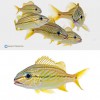 Grunts (family Haemulidae) are some of the most economically and ecologically important fishes found throughout the world. Their common name refers to the characteristic grunting sound they make when they are agitated and during courtship. Many species of grunts are popular in public and private aquariums due to their schooling behavior and bright colors that create interest in aquarium exhibits. The French grunt has recently been identified as a candidate species for aquaculture due to its popularity in aquarium displays and the development of culture protocols. This 4-page fact sheet was written by Kevin P. Barden, Matthew L. Wittenrich, and Eric J. Cassiano, and published by the UF Department of Fisheries and Aquatic Sciences, March 2014.
Grunts (family Haemulidae) are some of the most economically and ecologically important fishes found throughout the world. Their common name refers to the characteristic grunting sound they make when they are agitated and during courtship. Many species of grunts are popular in public and private aquariums due to their schooling behavior and bright colors that create interest in aquarium exhibits. The French grunt has recently been identified as a candidate species for aquaculture due to its popularity in aquarium displays and the development of culture protocols. This 4-page fact sheet was written by Kevin P. Barden, Matthew L. Wittenrich, and Eric J. Cassiano, and published by the UF Department of Fisheries and Aquatic Sciences, March 2014.
http://edis.ifas.ufl.edu/fa186
Cryptobia iubilans in Cichlids
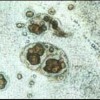 After many years of diagnostics at the University of Florida and at other laboratories around the country, it appears that Cryptobia iubilans is not uncommon among cichlids, and that environmental and other factors determine the extent of disease.This 3-page fact sheet was written by Ruth Francis-Floyd and Roy Yanong, and published by the UF Department of Fisheries and Aquatic Sciences, September 2014.
After many years of diagnostics at the University of Florida and at other laboratories around the country, it appears that Cryptobia iubilans is not uncommon among cichlids, and that environmental and other factors determine the extent of disease.This 3-page fact sheet was written by Ruth Francis-Floyd and Roy Yanong, and published by the UF Department of Fisheries and Aquatic Sciences, September 2014.
http://edis.ifas.ufl.edu/vm077
Hydrilla leafcutter moth (unofficial common name) Parapoynx diminutalis Snellen (Insecta: Lepidoptera: Crambidae)
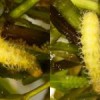 Parapoynx diminutalis Snellen is an adventive Asian moth with an aquatic larval stage. The moth is found associated with a variety of water bodies including river backwaters, lakes, and ponds. The aquatic larvae commonly attack hydrilla and other aquatic plants. The moth was identified in 1971 in India and Pakistan during scouting trips to attempt to determine potential biological control agents for hydrilla. Despite having potential for hydrilla destruction, the moth was declared to be a generalist feeder and unsuitable for release into U.S. water bodies for hydrilla control. But the moth was later found in Florida in 1976 by United States Department of Agriculture technicians who were testing herbicides for hydrilla control. The larvae found on hydrilla were observed to be eating the invasive weed. The pathway, method, or time of the moth’s arrival remains unknown. This 5-page fact sheet was written by Julie Baniszewski, Emma N.I. Weeks, and James P. Cuda, and published by the UF Department of Entomology and Nematology, January 2014.
Parapoynx diminutalis Snellen is an adventive Asian moth with an aquatic larval stage. The moth is found associated with a variety of water bodies including river backwaters, lakes, and ponds. The aquatic larvae commonly attack hydrilla and other aquatic plants. The moth was identified in 1971 in India and Pakistan during scouting trips to attempt to determine potential biological control agents for hydrilla. Despite having potential for hydrilla destruction, the moth was declared to be a generalist feeder and unsuitable for release into U.S. water bodies for hydrilla control. But the moth was later found in Florida in 1976 by United States Department of Agriculture technicians who were testing herbicides for hydrilla control. The larvae found on hydrilla were observed to be eating the invasive weed. The pathway, method, or time of the moth’s arrival remains unknown. This 5-page fact sheet was written by Julie Baniszewski, Emma N.I. Weeks, and James P. Cuda, and published by the UF Department of Entomology and Nematology, January 2014.
http://edis.ifas.ufl.edu/in1024
Koi Herpesvirus Disease (KHVD) (VM149/VM113)
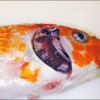 Koi herpesvirus (KHV) is a highly contagious virus that causes significant morbidity and mortality in common carp varieties. Common carp is raised as a foodfish in many countries and has also been selectively bred for the ornamental fish industry where it is known as koi. The first recognized case of KHV occurred in the United Kingdom in 1996. Since then other cases have been confirmed in almost all countries that culture koi and/or common carp with the exception of Australia. This 9-page fact sheet is intended to inform veterinarians, biologists, fish producers and hobbyists about KHV disease. Written by Kathleen H. Hartman, Roy P.E. Yanong, Deborah B. Pouder, B. Denise Petty, Ruth Francis-Floyd, Allen C. Riggs, and Thomas B. Waltzek, and published by the UF Department of Fisheries and Aquatic Sciences, April 2013.
Koi herpesvirus (KHV) is a highly contagious virus that causes significant morbidity and mortality in common carp varieties. Common carp is raised as a foodfish in many countries and has also been selectively bred for the ornamental fish industry where it is known as koi. The first recognized case of KHV occurred in the United Kingdom in 1996. Since then other cases have been confirmed in almost all countries that culture koi and/or common carp with the exception of Australia. This 9-page fact sheet is intended to inform veterinarians, biologists, fish producers and hobbyists about KHV disease. Written by Kathleen H. Hartman, Roy P.E. Yanong, Deborah B. Pouder, B. Denise Petty, Ruth Francis-Floyd, Allen C. Riggs, and Thomas B. Waltzek, and published by the UF Department of Fisheries and Aquatic Sciences, April 2013.
http://edis.ifas.ufl.edu/vm113
Grass Carp: A Fish for Biological Management of Hydrilla and Other Aquatic Weeds in Florida (BUL867/FA043)
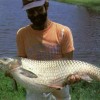 Abundant growth of aquatic plants causes serious problems in ponds, lakes, rivers, and irrigation and drainage throughout Florida. In some situations, native aquatic plants become weeds, but most often exotic plants introduced from areas outside the state flourish under the favorable growing conditions found in Florida. Long-term economical solutions to Florida’s aquatic weed problems have been elusive and there is a need for control techniques to alleviate aquatic weed problems. This 6-page fact sheet provides information on a biological method, the grass carp, for management of some of Florida’s aquatic weed problems. Written by David L. Sutton and Vernon V. Vandiver, Jr., and published by the UF Department of Fisheries and Aquatic Sciences, November 2013.
Abundant growth of aquatic plants causes serious problems in ponds, lakes, rivers, and irrigation and drainage throughout Florida. In some situations, native aquatic plants become weeds, but most often exotic plants introduced from areas outside the state flourish under the favorable growing conditions found in Florida. Long-term economical solutions to Florida’s aquatic weed problems have been elusive and there is a need for control techniques to alleviate aquatic weed problems. This 6-page fact sheet provides information on a biological method, the grass carp, for management of some of Florida’s aquatic weed problems. Written by David L. Sutton and Vernon V. Vandiver, Jr., and published by the UF Department of Fisheries and Aquatic Sciences, November 2013.
http://edis.ifas.ufl.edu/fa043

